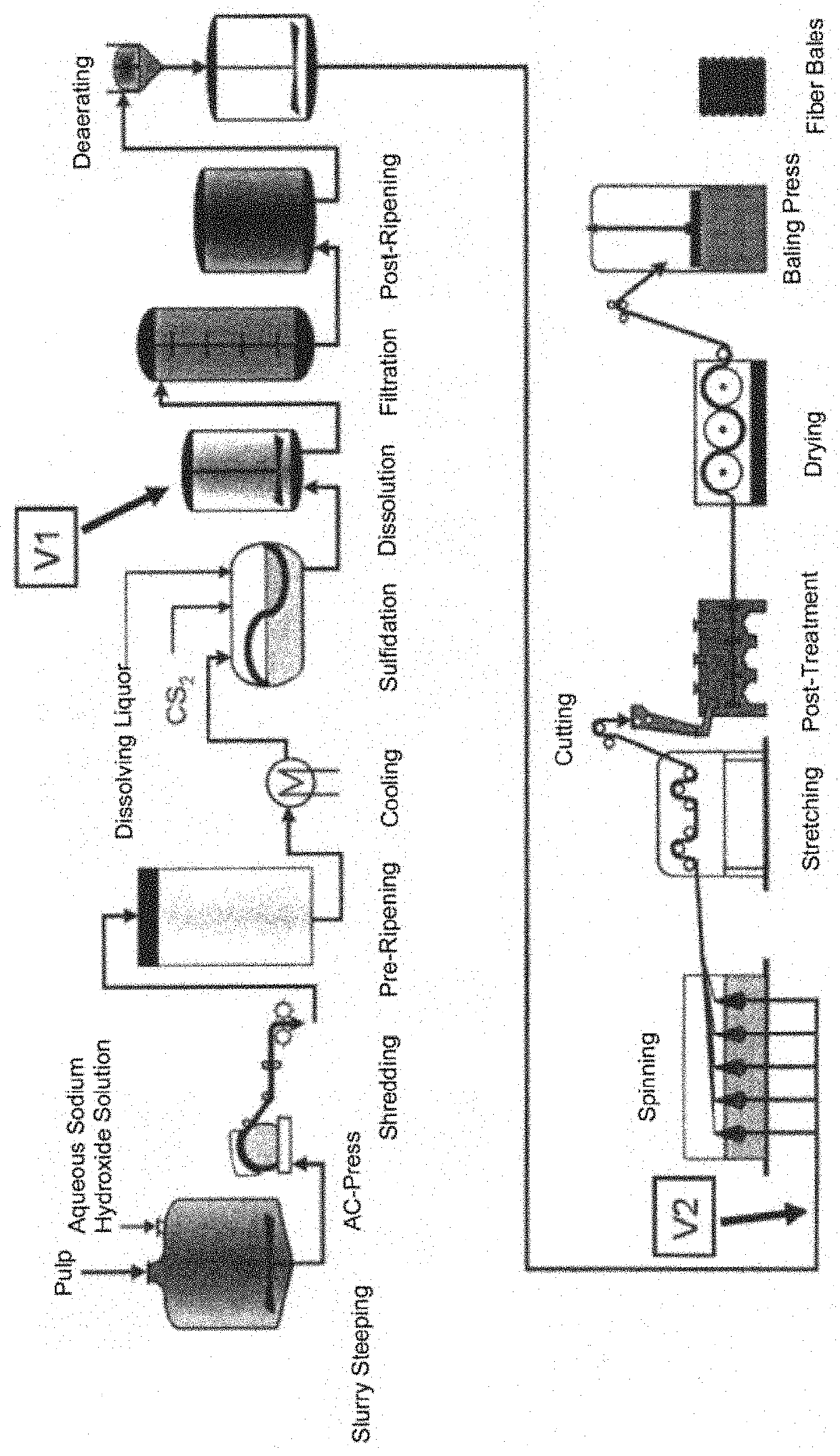Polysaccharide fibers and method for producing same
a technology of polysaccharide fibers and polysaccharide fibers, which is applied in the direction of synthetic cellulose fibres, textiles and papermaking, and bandages, etc., can solve the problems of high cost of solvents, affecting the cost-effectiveness of the entire process, and affecting the cost-effectiveness of the whole process
- Summary
- Abstract
- Description
- Claims
- Application Information
AI Technical Summary
Benefits of technology
Problems solved by technology
Method used
Image
Examples
example 1
[0036]A viscose xanthogenate containing 29.8% by weight of cellulose, 14.9% by weight of alkali, and 8% by weight of sulfur was reacted in a dissolving unit with a first dissolving liquor containing 4.5% by weight of NaOH and then with a second dissolving liquor containing 9% by weight of α(1→3)-glucan and 4.5% by weight of NaOH and finally with water. The viscose obtained in this way contains 9% by weight of fiber-forming material, 5.20% by weight of alkali, and 2.4% by weight of sulfur (calculated under the assumption that there are 100% by weight of cellulose as a fiber-forming material), with a ripeness index of 14 Hottenroth and a falling ball viscosity of 80 seconds (determined according to the Zellcheming Leaflet III / 5 / E). Viscose solutions with 10 and 25% of α(1→3)-glucan were prepared. These glucan quantities were related to the proportion of the α(1→3)-glucan in the fiber-forming substance. These viscose types contain 2.2% by weight of sulfur (10% by weight of glucan and 9...
example 2
[0039]A viscose containing 8.70% by weight of cellulose, 5.20% by weight of alkali, and 2.3% by weight of sulfur, with a ripeness index of 15 Hottenroth and a falling ball viscosity of 75 seconds (determined according to the Zellcheming Leaflet III / 5 / E), was, by means of a spinneret, extruded into a regeneration bath containing 100 g / l of sulfuric acid, 310 g / l of sodium sulfate, and 15 g / l of zinc sulfate. The spinneret had 1053 perforations with a diameter of 50 μm. 0.5% by weight of a nitrogen-containing auxiliary agent were added to the viscose spinning solution. In order to achieve adequate fiber strength, stretching by approx. 75% was carried out in the second bath (92° C., 15 g / l of H2SO4). The draw-off velocity was 50 m / min.
[0040]By using a positive displacement pump, various weight / weight percentages of a α(1→3)-glucan solution (prepared with 5% by weight of NaOH, 8% by weight of α(1→3)-glucan) were added to the viscose solution upstream from the spinneret, and fibers havin...
example 3
[0043]A modal viscose containing 6.0% by weight of cellulose, 6.20% by weight of alkali, and 1.8% by weight of sulfur, with a gamma value of 65 and a falling ball viscosity of 130 seconds (determined according to the Zellcheming Leaflet III / 5 / E) was, by means of a spinneret, extruded into a regeneration bath containing 72 g / l of sulfuric acid, 115 g / l of sodium sulfate, and 55 g / l of zinc sulfate. The spinneret had 1053 perforations with a diameter of 45 μm. 2.5% by weight of a nitrogen-containing auxiliary agent were added to the viscose spinning solution. In order to achieve adequate fiber strength, stretching by approx. 115% was carried out in the second bath (92° C., 15 g / l of H2SO4). The draw-off velocity was 50 m / min.
[0044]By using a positive displacement pump, various weight / weight percentages of a α(1→3)-glucan solution (prepared with 5% by weight of NaOH, 4.5% by weight of α(1→3)-glucan) were added to the viscose solution upstream from the spinneret, and fibers having 5 and...
PUM
| Property | Measurement | Unit |
|---|---|---|
| staple length | aaaaa | aaaaa |
| staple length | aaaaa | aaaaa |
| staple length | aaaaa | aaaaa |
Abstract
Description
Claims
Application Information
 Login to View More
Login to View More - R&D
- Intellectual Property
- Life Sciences
- Materials
- Tech Scout
- Unparalleled Data Quality
- Higher Quality Content
- 60% Fewer Hallucinations
Browse by: Latest US Patents, China's latest patents, Technical Efficacy Thesaurus, Application Domain, Technology Topic, Popular Technical Reports.
© 2025 PatSnap. All rights reserved.Legal|Privacy policy|Modern Slavery Act Transparency Statement|Sitemap|About US| Contact US: help@patsnap.com

